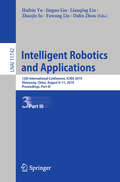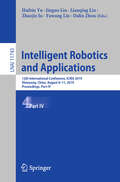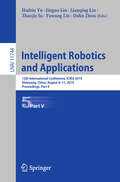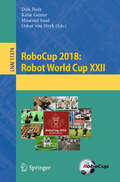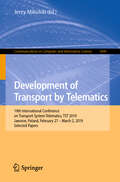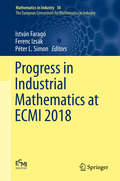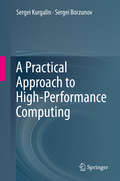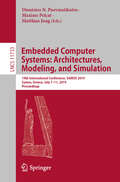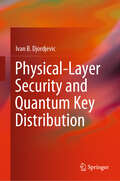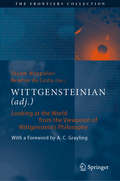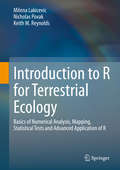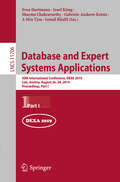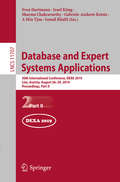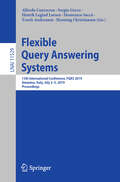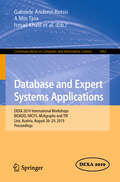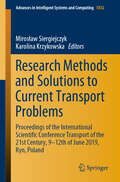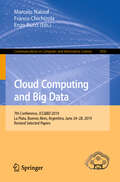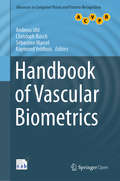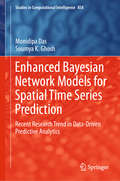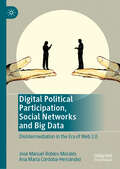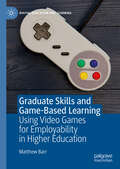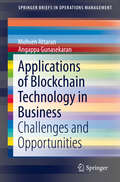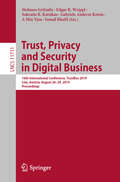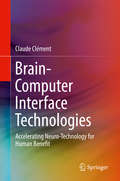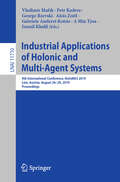- Table View
- List View
Intelligent Robotics and Applications: 12th International Conference, ICIRA 2019, Shenyang, China, August 8–11, 2019, Proceedings, Part III (Lecture Notes in Computer Science #11742)
by Haibin Yu Jinguo Liu Lianqing Liu Zhaojie Ju Yuwang Liu Dalin ZhouThe volume set LNAI 11740 until LNAI 11745 constitutes the proceedings of the 12th International Conference on Intelligent Robotics and Applications, ICIRA 2019, held in Shenyang, China, in August 2019. The total of 378 full and 25 short papers presented in these proceedings was carefully reviewed and selected from 522 submissions. The papers are organized in topical sections as follows:Part I: collective and social robots; human biomechanics and human-centered robotics; robotics for cell manipulation and characterization; field robots; compliant mechanisms; robotic grasping and manipulation with incomplete information and strong disturbance; human-centered robotics; development of high-performance joint drive for robots; modular robots and other mechatronic systems; compliant manipulation learning and control for lightweight robot. Part II: power-assisted system and control; bio-inspired wall climbing robot; underwater acoustic and optical signal processing for environmental cognition; piezoelectric actuators and micro-nano manipulations; robot vision and scene understanding; visual and motional learning in robotics; signal processing and underwater bionic robots; soft locomotion robot; teleoperation robot; autonomous control of unmanned aircraft systems. Part III: marine bio-inspired robotics and soft robotics: materials, mechanisms, modelling, and control; robot intelligence technologies and system integration; continuum mechanisms and robots; unmanned underwater vehicles; intelligent robots for environment detection or fine manipulation; parallel robotics; human-robot collaboration; swarm intelligence and multi-robot cooperation; adaptive and learning control system; wearable and assistive devices and robots for healthcare; nonlinear systems and control. Part IV: swarm intelligence unmanned system; computational intelligence inspired robot navigation and SLAM; fuzzy modelling for automation, control, and robotics; development of ultra-thin-film, flexible sensors, and tactile sensation; robotic technology for deep space exploration; wearable sensing based limb motor function rehabilitation; pattern recognition and machine learning; navigation/localization. Part V: robot legged locomotion; advanced measurement and machine vision system; man-machine interactions; fault detection, testing and diagnosis; estimation and identification; mobile robots and intelligent autonomous systems; robotic vision, recognition and reconstruction; robot mechanism and design. Part VI: robot motion analysis and planning; robot design, development and control; medical robot; robot intelligence, learning and linguistics; motion control; computer integrated manufacturing; robot cooperation; virtual and augmented reality; education in mechatronics engineering; robotic drilling and sampling technology; automotive systems; mechatronics in energy systems; human-robot interaction.
Intelligent Robotics and Applications: 12th International Conference, ICIRA 2019, Shenyang, China, August 8–11, 2019, Proceedings, Part IV (Lecture Notes in Computer Science #11743)
by Haibin Yu Jinguo Liu Lianqing Liu Zhaojie Ju Yuwang Liu Dalin ZhouThe volume set LNAI 11740 until LNAI 11745 constitutes the proceedings of the 12th International Conference on Intelligent Robotics and Applications, ICIRA 2019, held in Shenyang, China, in August 2019. The total of 378 full and 25 short papers presented in these proceedings was carefully reviewed and selected from 522 submissions. The papers are organized in topical sections as follows:Part I: collective and social robots; human biomechanics and human-centered robotics; robotics for cell manipulation and characterization; field robots; compliant mechanisms; robotic grasping and manipulation with incomplete information and strong disturbance; human-centered robotics; development of high-performance joint drive for robots; modular robots and other mechatronic systems; compliant manipulation learning and control for lightweight robot. Part II: power-assisted system and control; bio-inspired wall climbing robot; underwater acoustic and optical signal processing for environmental cognition; piezoelectric actuators and micro-nano manipulations; robot vision and scene understanding; visual and motional learning in robotics; signal processing and underwater bionic robots; soft locomotion robot; teleoperation robot; autonomous control of unmanned aircraft systems. Part III: marine bio-inspired robotics and soft robotics: materials, mechanisms, modelling, and control; robot intelligence technologies and system integration; continuum mechanisms and robots; unmanned underwater vehicles; intelligent robots for environment detection or fine manipulation; parallel robotics; human-robot collaboration; swarm intelligence and multi-robot cooperation; adaptive and learning control system; wearable and assistive devices and robots for healthcare; nonlinear systems and control. Part IV: swarm intelligence unmanned system; computational intelligence inspired robot navigation and SLAM; fuzzy modelling for automation, control, and robotics; development of ultra-thin-film, flexible sensors, and tactile sensation; robotic technology for deep space exploration; wearable sensing based limb motor function rehabilitation; pattern recognition and machine learning; navigation/localization. Part V: robot legged locomotion; advanced measurement and machine vision system; man-machine interactions; fault detection, testing and diagnosis; estimation and identification; mobile robots and intelligent autonomous systems; robotic vision, recognition and reconstruction; robot mechanism and design. Part VI: robot motion analysis and planning; robot design, development and control; medical robot; robot intelligence, learning and linguistics; motion control; computer integrated manufacturing; robot cooperation; virtual and augmented reality; education in mechatronics engineering; robotic drilling and sampling technology; automotive systems; mechatronics in energy systems; human-robot interaction.
Intelligent Robotics and Applications: 12th International Conference, ICIRA 2019, Shenyang, China, August 8–11, 2019, Proceedings, Part V (Lecture Notes in Computer Science #11744)
by Haibin Yu Jinguo Liu Lianqing Liu Zhaojie Ju Yuwang Liu Dalin ZhouThe volume set LNAI 11740 until LNAI 11745 constitutes the proceedings of the 12th International Conference on Intelligent Robotics and Applications, ICIRA 2019, held in Shenyang, China, in August 2019. The total of 378 full and 25 short papers presented in these proceedings was carefully reviewed and selected from 522 submissions. The papers are organized in topical sections as follows:Part I: collective and social robots; human biomechanics and human-centered robotics; robotics for cell manipulation and characterization; field robots; compliant mechanisms; robotic grasping and manipulation with incomplete information and strong disturbance; human-centered robotics; development of high-performance joint drive for robots; modular robots and other mechatronic systems; compliant manipulation learning and control for lightweight robot. Part II: power-assisted system and control; bio-inspired wall climbing robot; underwater acoustic and optical signal processing for environmental cognition; piezoelectric actuators and micro-nano manipulations; robot vision and scene understanding; visual and motional learning in robotics; signal processing and underwater bionic robots; soft locomotion robot; teleoperation robot; autonomous control of unmanned aircraft systems. Part III: marine bio-inspired robotics and soft robotics: materials, mechanisms, modelling, and control; robot intelligence technologies and system integration; continuum mechanisms and robots; unmanned underwater vehicles; intelligent robots for environment detection or fine manipulation; parallel robotics; human-robot collaboration; swarm intelligence and multi-robot cooperation; adaptive and learning control system; wearable and assistive devices and robots for healthcare; nonlinear systems and control. Part IV: swarm intelligence unmanned system; computational intelligence inspired robot navigation and SLAM; fuzzy modelling for automation, control, and robotics; development of ultra-thin-film, flexible sensors, and tactile sensation; robotic technology for deep space exploration; wearable sensing based limb motor function rehabilitation; pattern recognition and machine learning; navigation/localization. Part V: robot legged locomotion; advanced measurement and machine vision system; man-machine interactions; fault detection, testing and diagnosis; estimation and identification; mobile robots and intelligent autonomous systems; robotic vision, recognition and reconstruction; robot mechanism and design. Part VI: robot motion analysis and planning; robot design, development and control; medical robot; robot intelligence, learning and linguistics; motion control; computer integrated manufacturing; robot cooperation; virtual and augmented reality; education in mechatronics engineering; robotic drilling and sampling technology; automotive systems; mechatronics in energy systems; human-robot interaction.
RoboCup 2018: Robot World Cup XXII (Lecture Notes in Computer Science #11374)
by Dirk Holz Katie Genter Maarouf Saad Oskar Von StrykThis book includes the post-conference proceedings of the 22nd RoboCup International Symposium, held in Montreal, QC, Canada, in June 2018. The 32 full revised papers and 11 papers from the winning teams presented were carefully reviewed and selected from 51 submissions. This book highlights the approaches of champion teams from the competitions and documents the proceedings of the 22nd annual RoboCup International Symposium. Due to the complex research challenges set by the RoboCup initiative, the RoboCup International Symposium offers a unique perspective for exploring scientific and engineering principles underlying advanced robotic and AI systems.
Development of Transport by Telematics: 19th International Conference on Transport System Telematics, TST 2019, Jaworze, Poland, February 27 – March 2, 2019, Selected Papers (Communications in Computer and Information Science #1049)
by Jerzy MikulskiThis book constitutes selected papers from the 19th International Conference on Transport Systems Telematics, TST 2019, held in Jaworze, near Bielsko-Biala, Poland, in March 2019. The 31 full papers presented in this volume were carefully reviewed and selected from 104 submissions. They were organized in topical sections named: telematics in rail transport; telematics in road transport; telematics in marine transport; telematics in air transport; and general about telematics.
Progress in Industrial Mathematics at ECMI 2018 (Mathematics in Industry #30)
by István Faragó Péter L. Simon Ferenc IzsákThis book explores mathematics in a wide variety of applications, ranging from problems in electronics, energy and the environment, to mechanics and mechatronics. The book gathers 81 contributions submitted to the 20th European Conference on Mathematics for Industry, ECMI 2018, which was held in Budapest, Hungary in June 2018. The application areas include: Applied Physics, Biology and Medicine, Cybersecurity, Data Science, Economics, Finance and Insurance, Energy, Production Systems, Social Challenges, and Vehicles and Transportation. In turn, the mathematical technologies discussed include: Combinatorial Optimization, Cooperative Games, Delay Differential Equations, Finite Elements, Hamilton-Jacobi Equations, Impulsive Control, Information Theory and Statistics, Inverse Problems, Machine Learning, Point Processes, Reaction-Diffusion Equations, Risk Processes, Scheduling Theory, Semidefinite Programming, Stochastic Approximation, Spatial Processes, System Identification, and Wavelets. The goal of the European Consortium for Mathematics in Industry (ECMI) conference series is to promote interaction between academia and industry, leading to innovations in both fields. These events have attracted leading experts from business, science and academia, and have promoted the application of novel mathematical technologies to industry. They have also encouraged industrial sectors to share challenging problems where mathematicians can provide fresh insights and perspectives. Lastly, the ECMI conferences are one of the main forums in which significant advances in industrial mathematics are presented, bringing together prominent figures from business, science and academia to promote the use of innovative mathematics in industry.
A Practical Approach to High-Performance Computing
by Sergei Kurgalin Sergei BorzunovThe book discusses the fundamentals of high-performance computing. The authors combine visualization, comprehensibility, and strictness in their material presentation, and thus influence the reader towards practical application and learning how to solve real computing problems. They address both key approaches to programming modern computing systems: multithreading-based parallelizing in shared memory systems, and applying message-passing technologies in distributed systems. The book is suitable for undergraduate and graduate students, and for researchers and practitioners engaged with high-performance computing systems. Each chapter begins with a theoretical part, where the relevant terminology is introduced along with the basic theoretical results and methods of parallel programming, and concludes with a list of test questions and problems of varying difficulty. The authors include many solutions and hints, and often sample code.
Embedded Computer Systems: 19th International Conference, SAMOS 2019, Samos, Greece, July 7–11, 2019, Proceedings (Lecture Notes in Computer Science #11733)
by Dionisios N. Pnevmatikatos Maxime Pelcat Matthias JungThis book constitutes the refereed proceedings of the 19th International Conference on Embedded Computer Systems: Architectures, Modeling, and Simulation, SAMOS 2019, held in Pythagorion, Samos, Greece, in July 2019.The 21 regular papers presented were carefully reviewed and selected from 55 submissions. The papers are organized in topical sections on system design space exploration; deep learning optimization; system security; multi/many-core scheduling; system energy and heat management; many-core communication; and electronic system-level design and verification. In addition there are 13 papers from three special sessions which were organized on topics of current interest: insights from negative results; machine learning implementations; and European projects.
Physical-Layer Security and Quantum Key Distribution
by Ivan B. DjordjevicThis textbook integrates the most advanced topics of physical-layer security, cryptography, covert/stealth communications, quantum key distribution (QKD), and cyber security to tackle complex security issues. After introducing the reader to various concepts and practices, the author addresses how these can work together to target problems, rather than treating them as separate disciplines. This book offers students an in-depth exposition on: cryptography, information-theoretic approach to cryptography, physical-layer security, covert/stealth/low-probability of detection communications, quantum information theory, QKD, and cyber security; to mention few. The goal is to provide a unified description of the most advanced topics related to: (i) modern cryptography, (ii) physical-layer security, (iii) QKD, (iv) covert communications, and (v) cyber security. Each chapter is followed by a set of problems. Also, for readers to better understand the book, an appendix covers all needed background. Homework problems and lecture notes are available online. The book does not require any prior knowledge or prerequisite material.
WITTGENSTEINIAN: Looking at the World from the Viewpoint of Wittgenstein's Philosophy (The Frontiers Collection)
by Shyam Wuppuluri Newton Da Costa“Tell me," Wittgenstein once asked a friend, "why do people always say, it was natural for man to assume that the sun went round the earth rather than that the earth was rotating?" His friend replied, "Well, obviously because it just looks as though the Sun is going round the Earth." Wittgenstein replied, "Well, what would it have looked like if it had looked as though the Earth was rotating?” What would it have looked like if we looked at all sciences from the viewpoint of Wittgenstein’s philosophy? Wittgenstein is undoubtedly one of the most influential philosophers of the twentieth century. His complex body of work has been analysed by numerous scholars, from mathematicians and physicists, to philosophers, linguists, and beyond. This volume brings together some of his central perspectives as applied to the modern sciences and studies the influence they may have on the thought processes underlying science and on the world view it engenders. The contributions stem from leading scholars in philosophy, mathematics, physics, economics, psychology and human sciences; all of them have written in an accessible style that demands little specialist knowledge, whilst clearly portraying and discussing the deep issues at hand.
Introduction to R for Terrestrial Ecology: Basics of Numerical Analysis, Mapping, Statistical Tests and Advanced Application of R
by Keith M. Reynolds Milena Lakicevic Nicholas PovakThis textbook covers R data analysis related to environmental science, starting with basic examples and proceeding up to advanced applications of the R programming language. The main objective of the textbook is to serve as a guide for undergraduate students, who have no previous experience with R, but part of the textbook is dedicated to advanced R applications, and will also be useful for Masters and PhD students, and professionals. The textbook deals with solving specific programming tasks in R, and tasks are organized in terms of gradually increasing R proficiency, with examples getting more challenging as the chapters progress. The main competencies students will acquire from this textbook are: manipulating and processing data tablesperforming statistical testscreating maps in R This textbook will be useful in undergraduate and graduate courses in Advanced Landscape Ecology, Analysis of Ecological and Environmental Data, Ecological Modeling, Analytical Methods for Ecologists, Statistical Inference for Applied Research, Elements of Statistical Methods, Computational Ecology, Landscape Metrics and Spatial Statistics.
Database and Expert Systems Applications: 30th International Conference, DEXA 2019, Linz, Austria, August 26–29, 2019, Proceedings, Part I (Lecture Notes in Computer Science #11706)
by Sven Hartmann Josef Küng Sharma Chakravarthy Gabriele Anderst-Kotsis A Min Tjoa Ismail KhalilThis two volume set of LNCS 11706 and LNCS 11707 constitutes the refereed proceedings of the 30th International Conference on Database and Expert Systems Applications, DEXA 2019, held in Linz, Austria, in August 2019. The 32 full papers presented together with 34 short papers were carefully reviewed and selected from 157 submissions. The papers are organized in the following topical sections: Part I: Big data management and analytics; data structures and data management; management and processing of knowledge; authenticity, privacy, security and trust; consistency, integrity, quality of data; decision support systems; data mining and warehousing. Part II: Distributed, parallel, P2P, grid and cloud databases; information retrieval; Semantic Web and ontologies; information processing; temporal, spatial, and high dimensional databases; knowledge discovery; web services.
Database and Expert Systems Applications: 30th International Conference, DEXA 2019, Linz, Austria, August 26–29, 2019, Proceedings, Part II (Lecture Notes in Computer Science #11707)
by Sven Hartmann Josef Küng Sharma Chakravarthy Gabriele Anderst-Kotsis A Min Tjoa Ismail KhalilThis two volume set of LNCS 11706 and LNCS 11707 constitutes the refereed proceedings of the 30th International Conference on Database and Expert Systems Applications, DEXA 2019, held in Linz, Austria, in August 2019.The 32 full papers presented together with 34 short papers were carefully reviewed and selected from 157 submissions. The papers are organized in the following topical sections: Part I: Big data management and analytics; data structures and data management; management and processing of knowledge; authenticity, privacy, security and trust; consistency, integrity, quality of data; decision support systems; data mining and warehousing. Part II: Distributed, parallel, P2P, grid and cloud databases; information retrieval; Semantic Web and ontologies; information processing; temporal, spatial, and high dimensional databases; knowledge discovery; web services.
Flexible Query Answering Systems: 13th International Conference, FQAS 2019, Amantea, Italy, July 2–5, 2019, Proceedings (Lecture Notes in Computer Science #11529)
by Alfredo Cuzzocrea Sergio Greco Henrik Legind Larsen Domenico Saccà Troels Andreasen Henning ChristiansenThis book constitutes the refereed proceedings of the 13th International Conference on Flexible Query Answering Systems, FQAS 2019, held in Amantea, Italy, in July 2019.The 27 full papers and 10 short papers presented were carefully reviewed and selected from 43 submissions. The papers present emerging research trends with a special focus on flexible querying and analytics for smart cities and smart societies in the age of big data. They are organized in the following topical sections: flexible database management and querying; ontologies and knowledge bases; social networks and social media; argumentation-based query answering; data mining and knowledge discovery; advanced flexible query answering methodologies and techniques; flexible query answering methods and techniques; flexible intelligent information-oriented and network-oriented approaches; big data veracity and soft computing; flexibility in tools; and systems and miscellanea.
Database and Expert Systems Applications: DEXA 2019 International Workshops BIOKDD, IWCFS, MLKgraphs and TIR, Linz, Austria, August 26–29, 2019, Proceedings (Communications in Computer and Information Science #1062)
by Gabriele Anderst-Kotsis A Min Tjoa Ismail Khalil Mourad Elloumi Atif Mashkoor Johannes Sametinger Xabier Larrucea Anna Fensel Jorge Martinez-Gil Bernhard Moser Christin Seifert Benno Stein Michael GranitzerThis volume constitutes the refereed proceedings of the four workshops held at the 30th International Conference on Database and Expert Systems Applications, DEXA 2019, held in Linz, Austria, in August 2019: The 10th International Workshop on Biological Knowledge Discovery from Data, BIOKDD 2019, the 3rd International Workshop on Cyber-Security and Functional Safety in Cyber-Physical Systems, IWCFS 2019, the 1st International Workshop on Machine Learning and Knowledge Graphs, MLKgraphs2019, and the 16th International Workshop on Technologies for Information Retrieval, TIR 2019. The 26 selected papers discuss a range of topics including: knowledge discovery, biological data, cyber security, cyber-physical system, machine learning, knowledge graphs, information retriever, data base, and artificial intelligent.
Research Methods and Solutions to Current Transport Problems: Proceedings of the International Scientific Conference Transport of the 21st Century, 9– 12th of June 2019, Ryn, Poland (Advances in Intelligent Systems and Computing #1032)
by Mirosław Siergiejczyk Karolina KrzykowskaThe book is dedicated as an auxiliary literature for academic staff of universities, research institutes, as well as for students of transport teaching. The aim of the conference was to present the achievements of national and foreign research and scientific centers dealing with the issues of rail, road, air and sea transport in technical and technological aspects, as well as organization and integration of the environment conducting research and education in the discipline of civil engineering and transport. International Scientific Conference Transport of the 21st Century was held in Ryn, Poland, in the 9th–12th of June 2019.The research areas of the conference were as follows:• transport infrastructure and communication engineering,• construction and operation of means of transport,• logistics engineering and transport technology,• organization and planning of transport, including public transport,• traffic control systems in transport,• transport telematics and intelligent transportation systems,• smart city and electromobility,• safety engineering and ecology in transport,• automation of means of transport.It also used by specialists from central and local government authorities in the area of deepening knowledge of modern technologies and solutions used for planning, managing and operating transport.
Cloud Computing and Big Data: 7th Conference, JCC&BD 2019, La Plata, Buenos Aires, Argentina, June 24–28, 2019, Revised Selected Papers (Communications in Computer and Information Science #1050)
by Marcelo Naiouf Franco Chichizola Enzo RucciThis book constitutes the revised selected papers of the 7th International Conference on Cloud Computing and Big Data, JCC&BD 2019, held in La Plata, Buenos Aires, Argentina, in June 2019.The 12 full papers presented were carefully reviewed and selected from a total of 31 submissions. They are dealing with such topics as cloud computing and HPC; Big Data and data intelligence; mobile computing.
Handbook of Vascular Biometrics (Advances in Computer Vision and Pattern Recognition)
by Sébastien Marcel Andreas Uhl Christoph Busch Raymond VeldhuisThis open access handbook provides the first comprehensive overview of biometrics exploiting the shape of human blood vessels for biometric recognition, i.e. vascular biometrics, including finger vein recognition, hand/palm vein recognition, retina recognition, and sclera recognition. After an introductory chapter summarizing the state of the art in and availability of commercial systems and open datasets/open source software, individual chapters focus on specific aspects of one of the biometric modalities, including questions of usability, security, and privacy. The book features contributions from both academia and major industrial manufacturers.
Enhanced Bayesian Network Models for Spatial Time Series Prediction: Recent Research Trend in Data-Driven Predictive Analytics (Studies in Computational Intelligence #858)
by Monidipa Das Soumya K. GhoshThis research monograph is highly contextual in the present era of spatial/spatio-temporal data explosion. The overall text contains many interesting results that are worth applying in practice, while it is also a source of intriguing and motivating questions for advanced research on spatial data science. The monograph is primarily prepared for graduate students of Computer Science, who wish to employ probabilistic graphical models, especially Bayesian networks (BNs), for applied research on spatial/spatio-temporal data. Students of any other discipline of engineering, science, and technology, will also find this monograph useful. Research students looking for a suitable problem for their MS or PhD thesis will also find this monograph beneficial. The open research problems as discussed with sufficient references in Chapter-8 and Chapter-9 can immensely help graduate researchers to identify topics of their own choice. The various illustrations and proofs presented throughout the monograph may help them to better understand the working principles of the models. The present monograph, containing sufficient description of the parameter learning and inference generation process for each enhanced BN model, can also serve as an algorithmic cookbook for the relevant system developers.
Digital Political Participation, Social Networks and Big Data: Disintermediation in the Era of Web 2.0
by José Manuel Robles-Morales Ana María Córdoba-HernándezThis book explores the changes in political communication in light of the development of a public opinion mediated by web 2.0 technologies. One of the most important changes in political communication is related to the process of disintermediation, i.e. the process by which digital technologies allow citizens to compete in the public space with those agents who, traditionally, co-opted public opinion. However, while disintermediation has undeniably generated a number of advances, having linked citizens to the public debate, the authors highlight some aspects where disintermediation is moving away from a rational and inclusive public space. They argue that these aspects, related to the immediacy, polarization and incivility of the communication, obscure the possibilities for democratization of digital political communication.
Graduate Skills and Game-Based Learning: Using Video Games for Employability in Higher Education (Digital Education and Learning)
by Matthew BarrThis book explores the efficacy of game-based learning to develop university students’ skills and competencies. While writing on game-based learning has previously emphasised the use of games developed specifically for educational purposes, this book fills an important gap in the literature by focusing on commercial games such as World of Warcraft and Minecraft. Underpinned by robust empirical evidence, the author demonstrates that the current negative perception of video games is ill-informed, and in fact these games can be important tools to develop graduate skills related to employability. Speaking to very current concerns about the employability of higher education graduates and the skills that university is intended to develop, this book also explores the attitudes to game-based learning as expressed by instructors, students and game developers.
Applications of Blockchain Technology in Business: Challenges and Opportunities (SpringerBriefs in Operations Management)
by Mohsen Attaran Angappa GunasekaranThe book discusses the various ways that blockchain technology is changing the future of money, transactions, government, and business. The first two chapters walk through the foundation of blockchain. Chapters 3–12 look at applications of blockchain in different industries and highlight its exciting new business applications. It show why so many companies are implementing blockchain, and present examples of companies who have successfully employed the technology to improve efficiencies and reduce costs. Chapter 13 highlights blockchain’s powerful potential to foster emerging markets and economies including smart cities, value-based healthcare, decentralized sharing economy, machine to machine transactions, data-sharing marketplace, etc. Chapter 14 offers a conceptual model, provides information and insights, and covers a step-by-step approach to plan and develop blockchain-based technology.
Trust, Privacy and Security in Digital Business: 16th International Conference, TrustBus 2019, Linz, Austria, August 26–29, 2019, Proceedings (Lecture Notes in Computer Science #11711)
by Stefanos Gritzalis Edgar R. Weippl Sokratis K. Katsikas Gabriele Anderst-Kotsis A Min Tjoa Ismail KhalilThis book constitutes the refereed proceedings of the 16th International Conference on Trust, Privacy and Security in Digital Business, TrustBus 2019, held in Linz, Austria, in August 2019 in conjunction with DEXA 2019. The 11 full papers presented were carefully reviewed and selected from 24 submissions. The papers are organized in the following topical sections: privacy; and audit, compliance and threat intelligence.The chapter "A data utility-driven benchmark for de-identification methods" is open access under a CC BY 4.0 license at link.springer.com.
Brain-Computer Interface Technologies: Accelerating Neuro-Technology for Human Benefit
by Claude ClémentThis book is about the field of brain-computer interfaces (BCI) and the unique and special environment of active implants that electrically interface with the brain, spinal cord, peripheral nerves, and organs. At the heart of the book is the matter of repairing and rehabilitating patients suffering from severe neurologic impairments, from paralysis to movement disorders and epilepsy, that often requires an invasive solution based on an implanted device. Past achievements, current work, and future perspectives of BCI and other interactions between medical devices and the human nervous system are described in detail from a pragmatic point of view.Reviews the Active Implantable Medical Devices (AIMDs) industry and how it is moving from cardiac to neuro applicationsClear, easy to read, presentation of the field of neuro-technologies for human benefitProvides easy to understand explanations about the technical limitations, the physics of implants in the human body, and realistic long terms perspectives
Industrial Applications of Holonic and Multi-Agent Systems: 9th International Conference, HoloMAS 2019, Linz, Austria, August 26–29, 2019, Proceedings (Lecture Notes in Computer Science #11710)
by Vladimír Mařík Petr Kadera George Rzevski Alois Zoitl Gabriele Anderst-Kotsis A Min Tjoa Ismail KhalilThis book constitutes the refereed proceedings of the 9th International Conference on Industrial Applications of Holonic and Multi-Agent Systems, HoloMAS 2019, held in Linz, Austria, in August 2019. The 14 full papers presented were carefully reviewed and selected from 15 submissions, and 2 invited papers were also included. The papers are organized in the following topical sections: invited talks; methodologies and framework; agent-based production scheduling and control; data and knowledge; and MAS in various areas.
